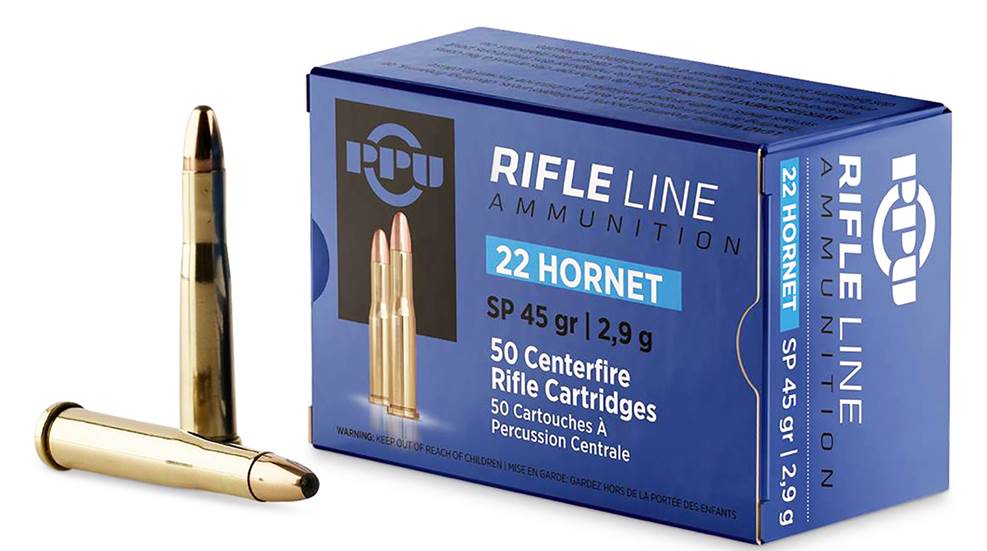
The period from 1873 through about 1960 is, for me, the most fascinating period of cartridge and firearm development. So many different things were going on, from repeating firearms, the development of self-contained metallic cartridges, smokeless powders, bolt-actions, double-actions, semi- and full-automatics, jacketed bullets and telescopic sights, just to name a few.
Here we will take a look at a cartridge conceived in the blackpowder era that transitioned into the smokeless-powder era, with little more than a slight change in bullet construction and propellant. And like many cartridges of this era, it lives on today with a devoted—if not overly large—group of fans. That cartridge is the .22 Hornet. It started when Winchester spawned a small-game, black-powder cartridge in 1885 called the .22 Winchester Center Fire. It was originally chambered in the company’s then-new Model 1885 single-shot rifle.
Some 19 years later, Remington would chamber the No. 7 Rolling Block in .22 W.C.F., as well. The case was a diminutive proportioned bottleneck design with a long, sloping body and a scant 5-degree shoulder to facilitate extraction in the dirty-burning, black-powder rifles of the day. A 45-grain cast lead flat-point bullet in front of 13 grains of black powder turned up some 1,550 f.p.s. of muzzle velocity. The cartridge had widespread popularity as a small-game, target and varmint round. Yet with the advent of smokeless powders, shooters desired something that fouled less and could be shot more.
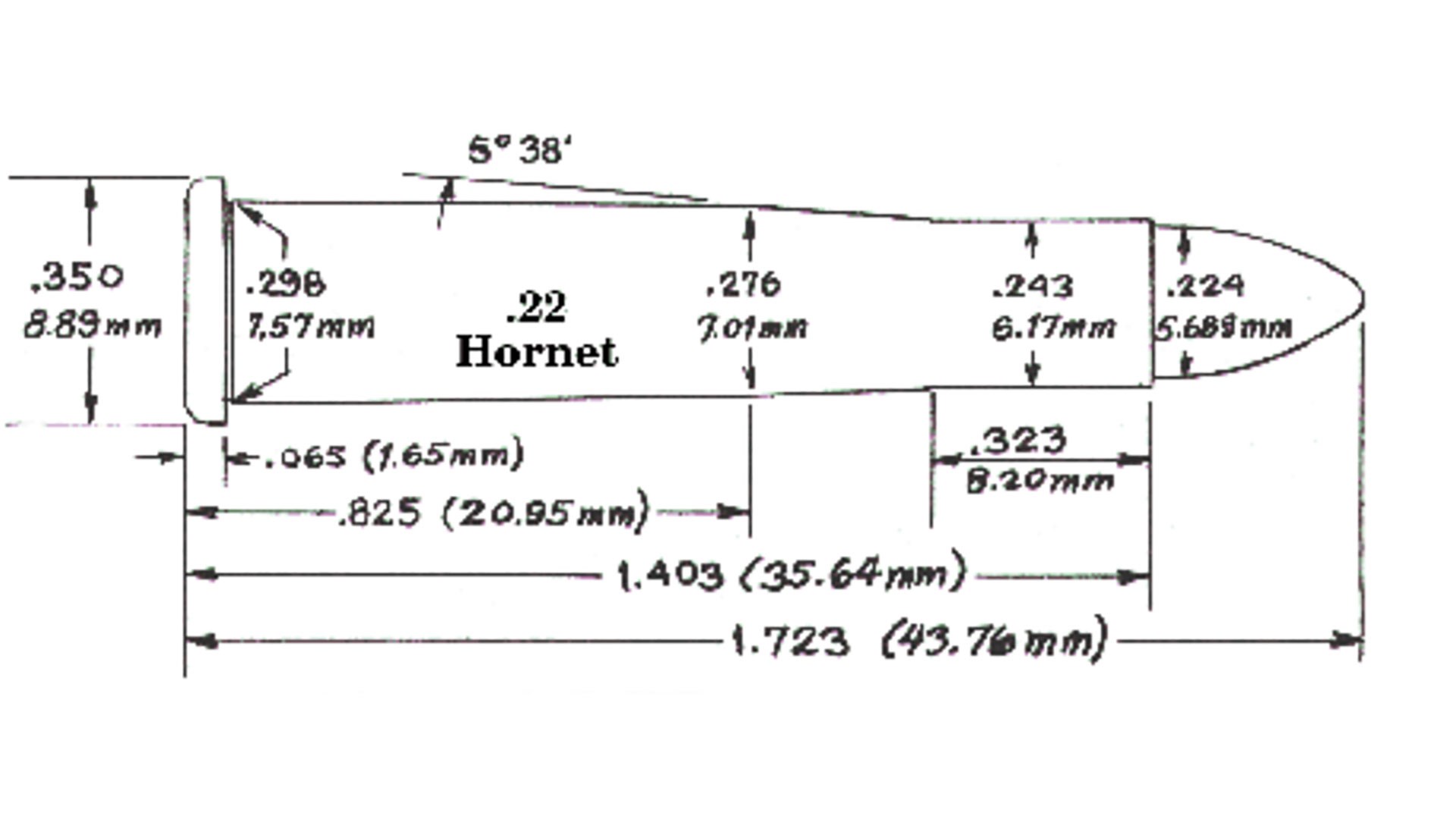 A dimensional schematic of the .22 Hornet cartridge.
A dimensional schematic of the .22 Hornet cartridge.
During the 1920s, experimenters at Springfield Armory led by Capt. Grosvenor Wotkyns, and later Col. Townsend Whelen, tweaked the cartridge for a while, and by 1930, the .22 Hornet debuted. The case is virtually identical to its parent .22 W.C.F. cartridge, although the black-powder version typically was loaded with bullets .228″ in diameter. Hornets were initially loaded with .223″ jacketed bullets, and have now settled on .224″ bullets. With smokeless powders having more energy-to-weight, the same 45-gr. bullets were launched at 2,400 f.p.s., albeit they were jacketed bullets.
The .22 Hornet was touted by Winchester engineers as the most accurate ever tested in their labs at that time. Winchester’s .22 Hornet enjoyed even more widespread popularity, quickly enough that, by 1936, the .22 W.C.F. was no longer loaded, despite the fact that until 1932 no factory rifle had been chambered for the .22 Hornet. Sales brochures of the era touted the .22 Hornet as a 200-yard rifle, but in practice it was more suited to targets no further than 125 yards.
Handloaders and backyard experimenters had a field day with the Hornet, so much so that bullets from 34 to 55 grains have been tried in it. Today most factory loads and handloads utilize bullets from 35 to 46 grains and have very frangible construction. Velocities are usually in the 2,700 f.p.s. range with modern powders and extend the usable range of the .22 Hornet out to 175 yards.
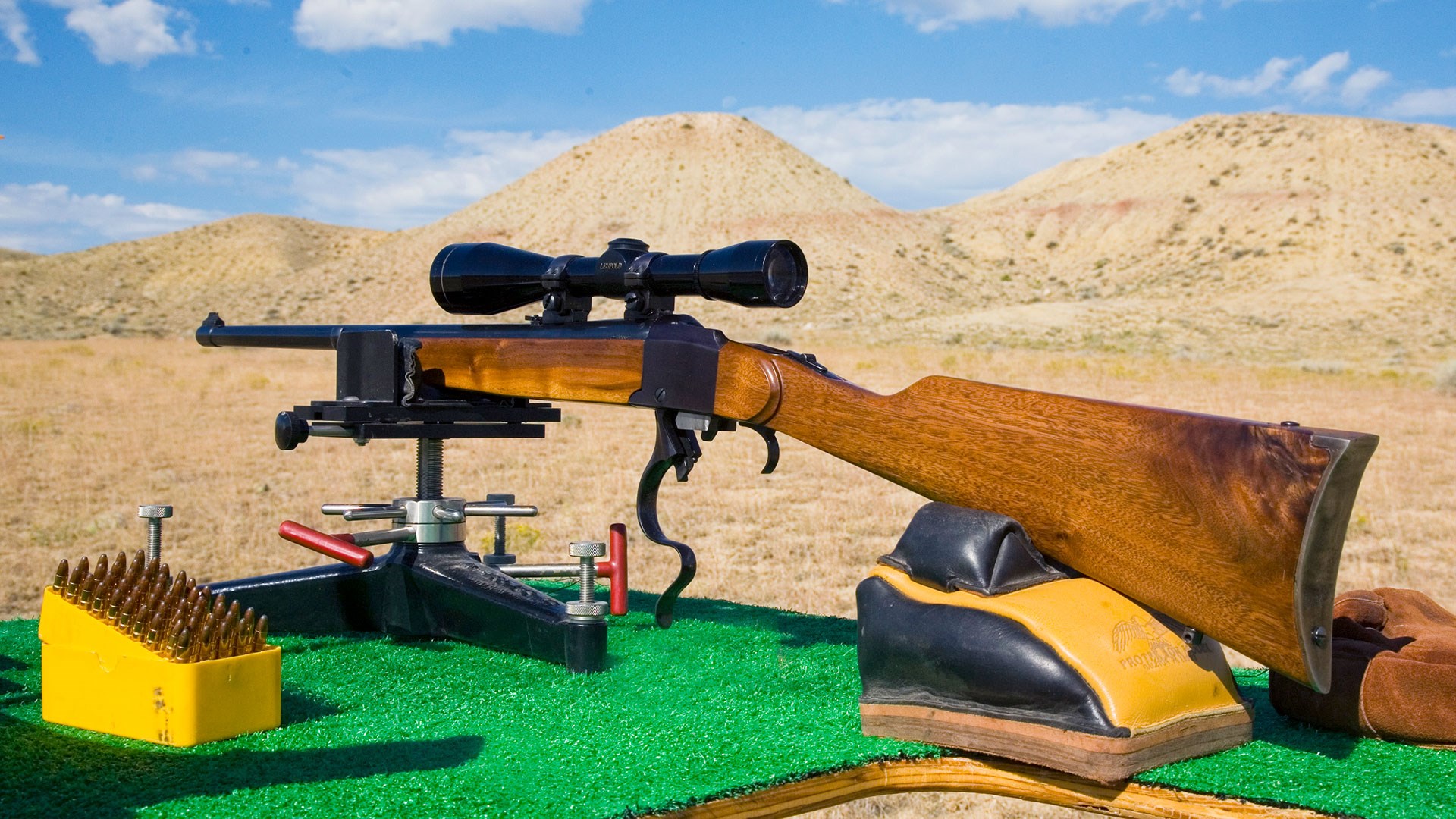
Those who want or need a relatively quiet, light-recoiling and inexpensive-to-shoot firearm seem to love the Hornet. It can be used in somewhat settled farm country to keep the rodent population in check without scaring the neighbors. Powder charges generally range from 12 to 20 grains, depending on the powder, so one gets a lot of loaded rounds from a pound of powder. The .22 Hornet has a bit of history as a target and training cartridge, as well.
In such places as Australia and New Zealand, the cartridge was not only was popular with small-game and vermin shooters, it was a favorite for cadets in training as well. It was quite popular in Europe, where the Germans call it the 5.6×35 mm R. CZ-USA still chambers its premium 527 Lux in styles targeting American and European markets. Handloaders have gotten more performance than factory ammo makers have been able to until recently.
For decades, the .22 Hornet factory loads spit out 45-grain bullets at 2,400 to 2,500 f.p.s. Handloaders were getting some 2,700 f.p.s. and more with the same bullets using powders like the then Hercules, now Alliant 2400, along with IMR 4227. That still wasn’t enough for many, so enter the wildcatters. The most popular wildcat off the .22 Hornet is the .22 K-Hornet, developed by Lysle Killborn in 1940. More than a few other wildcats were made, but Killborn’s has kept most of its legs.
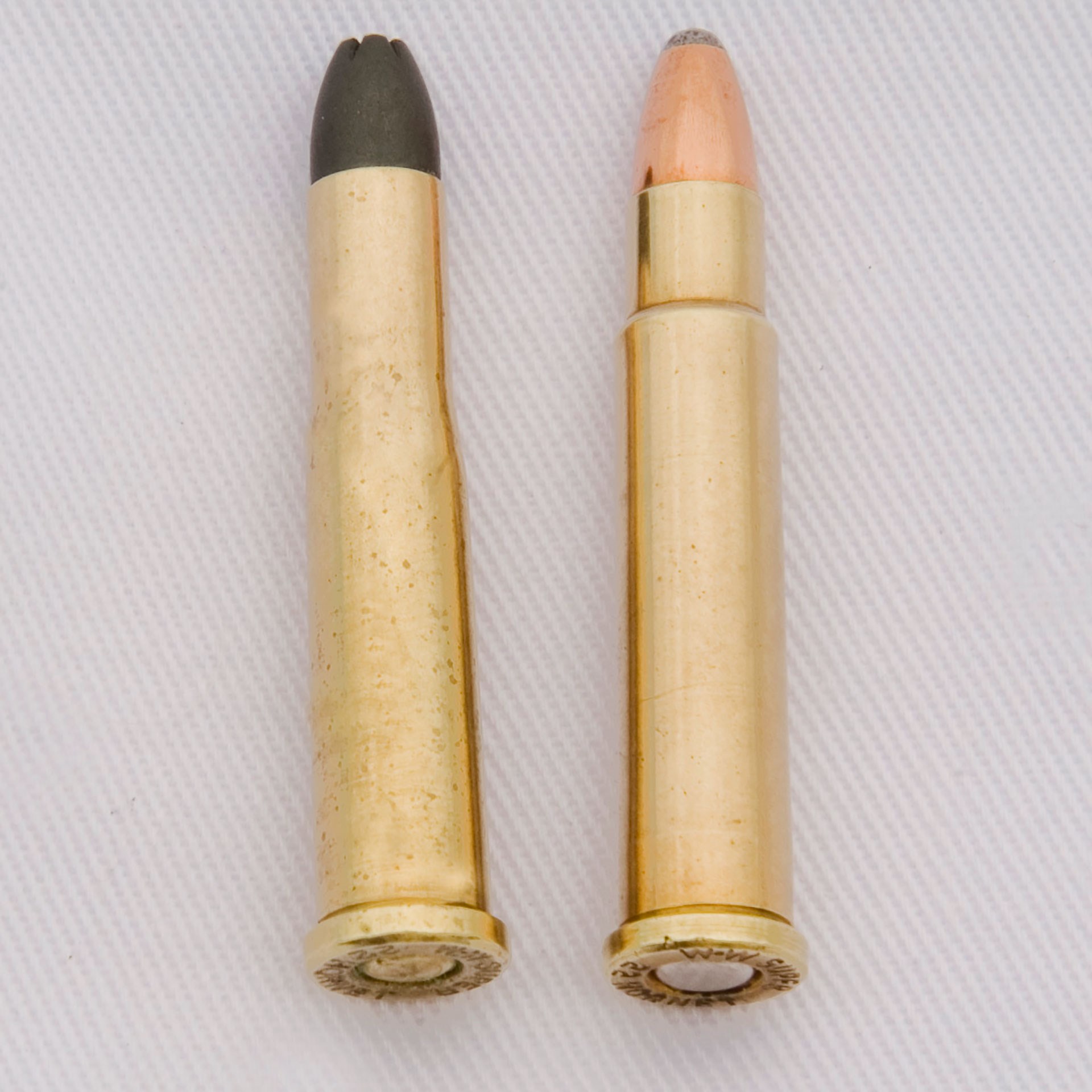 The standard .22 Hornet on the left compared with the .22 K-Hornet on the right.
The standard .22 Hornet on the left compared with the .22 K-Hornet on the right.
As one of the first of the “improved cartridges,” the .22 K-Hornet generated another 200 f.p.s. more than the standard Hornet. The .22 K-Hornet’s increased powder capacity—made by fire-forming the taper out of the case and giving it a sharp 40-degree shoulder—offered a real improvement and increased point-blank-range capability. I fell for the siren song of the K-Hornet some 44 years ago when I had my Ruger No. 3 reamed out to .22 K-Hornet.
After trying several bullets from 45 to 52 grains, I finally settled on a Sierra 45-grain Varminter bullet in front of 20.0 grains of IMR 4198 and producing 2,888 fps from the 22″ barrel of my No. 3. I even shot a Lyman 225415 (now discontinued), 50-grain, flat-point cast bullet with a gas check for some time. In front of 4.0 grains of then-Hercules Unique, it was deadly on red fox at 50 to 75 yards. When I quit night hunting fox, I give up on it because installing the dinky .22-cal. gas checks became too much of a hassle. P.O. Ackley necked the Hornet down to .17 caliber in the 1950s, creating a .17 Hornet.
Bullet technology being what it was in the 1950s, the .17 Hornet was mildly successful. However, when Hornady brought out the .17 Hornet as a factory round a few years ago and companies like Savage, CZ-USA, Ruger and others began chambering it, senior pest and varmint shooters eagerly flocked toward it. The Hornady load sends a 20-grain V-Max bullet out of a 24″ barrel at 3,650 fps with a trajectory of just over plus-or-minus 3″ over 300 yards. Winchester Ammunition also loads a 20-grain, polymer tipped bullet to 3,650 fps with similar trajectory, as does Federal.
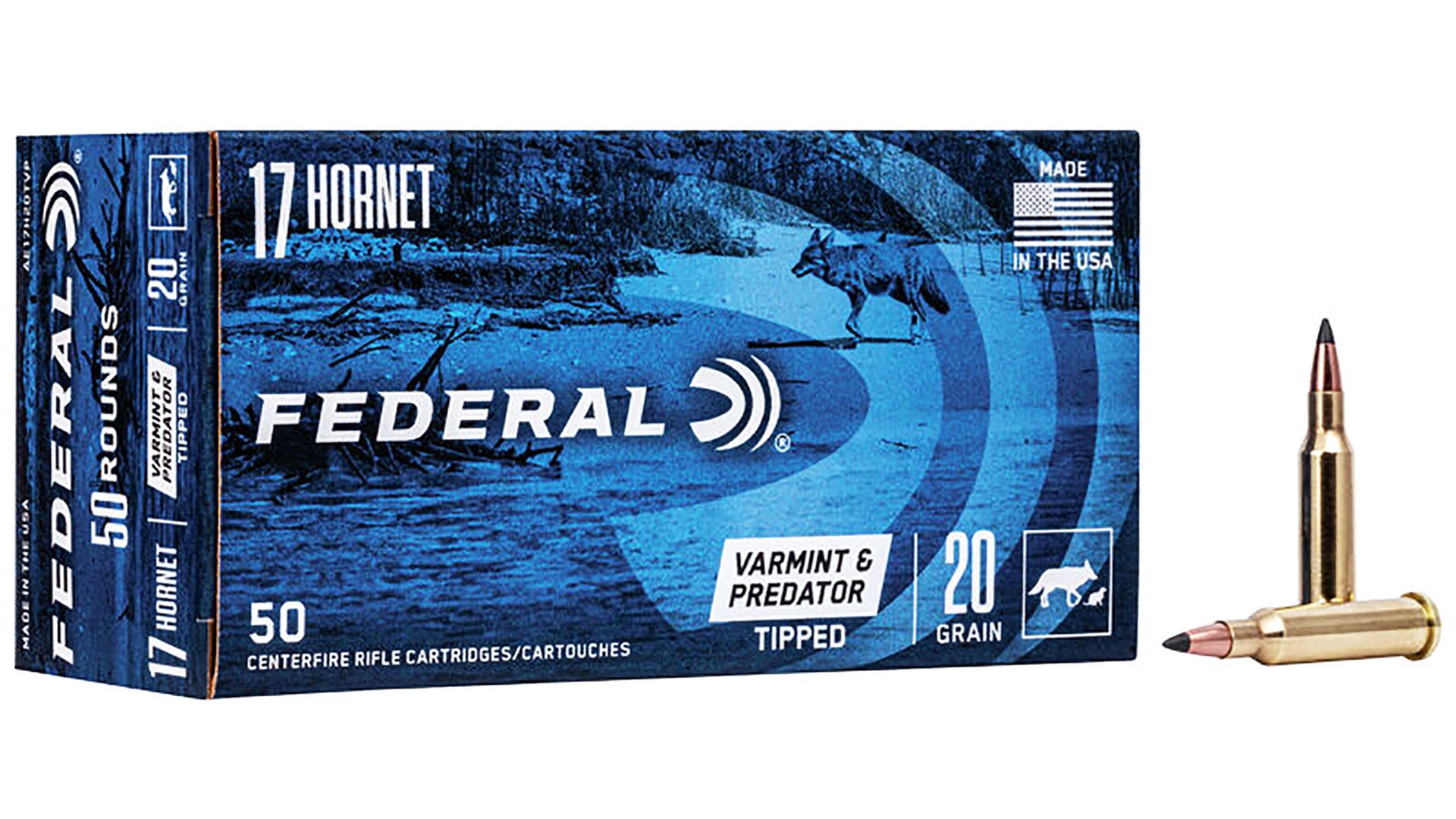 A box of Federal 20-grain .17 Hornet.
A box of Federal 20-grain .17 Hornet.
Prairie dog shooters love it. It is sometimes said that classic designs never go out of fashion. Sure, the hotshot .22-cal. cartridges like the .223 Rem., .22-250 Rem. and .220 Swift get most of the attention and ink. But most hits on varmints from field positions—i.e. the shooter hasn’t hauled a shooting bench out into the field, he must shoot from position or at least on sticks—occur at less than 200 yards. For that kind of shooting—and hitting—the nearly century-old Hornet remains a fine choice.